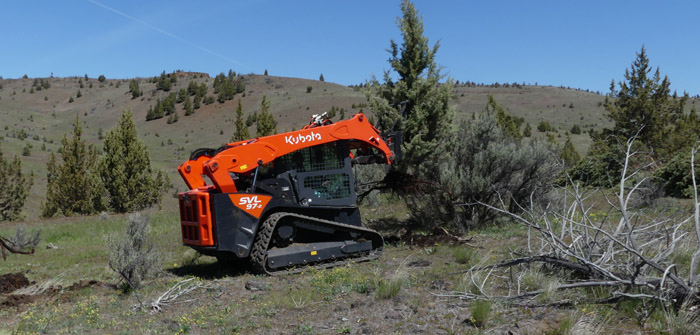(Pincher mounted to a skid steer removing juniper, Little Trout Creek project first day of juniper removal | Photo courtesy of Oregon Watershed Enhancement Board)
Projects will use Prescribed Burning, Artificial Beaver Dams in Deschutes River Basin
The Oregon Watershed Enhancement Board (OWEB) has awarded $587,919 to the Jefferson County Soil and Watershed Conservation District for two projects aimed at improving water quality and restoring habitat for fish and wildlife in two parts of the Deschutes River Basin in Jefferson County.
OWEB granted $121,007 to help the conservation district and partners install structures known as beaver dam analogs in Campbell Creek, which flows into the lower Deschutes River. Constructed of natural materials like untreated lodgepole posts and woody limbs, these artificial structures mimic the dams that beavers create, slowing water flow and trapping pollutant-laden sediment before it reaches the Deschutes River. The beaver dam analogs will be installed in Campbell Creek in early 2023.
“Beaver dam analogs act as natural water filters. They can help remove many of the pollutants present in the creek,” said Ally Steinmetz, watershed coordinator for the Middle Deschutes Watershed Council, which is partnering with the conservation district on the project. “By slowing down the movement of water, they also help reconnect the floodplain to the creek, which promotes streamside vegetation and habitat.”
OWEB also approved a second grant totaling $466,912 to the conservation district for a project in the Trout Creek watershed, an eastside tributary of the Deschutes River. Decades of grazing, fire suppression and climate change have allowed juniper trees to encroach into what should be grassland. The conservation district will first remove the junipers, then conduct five prescribed burns over the next four years to clean up the resulting biomass and invigorate the growth of the native grasses and shrubs. Parts of the area will also be re-seeded with native grasses.
“Removing the junipers will return the landscape to a healthy grassland ecosystem,” said Adam Haarberg, a project manager with the conservation district. “A healthy grassland has native bunchgrasses and shrubs that enable the soil to capture, store and safely release what little precipitation the region receives. Juniper, on the other hand, are very thirsty and will hold on to the water, a detriment to the native plants that wildlife use.” In addition, native grasses and shrubs provide much better habitat and forage than juniper for native wildlife species including mule deer, elk, and ground-nesting birds.
The project, which will begin this spring and be completed in fall 2026, covers more than 1,700 acres. Previously, OWEB funded two other juniper-removal projects that the conservation district has underway in the Trout Creek watershed, both of which Haarberg said are showing “great promise.”
About the Jefferson County Soil and Water Conservation District
The Jefferson County Soil and Water Conservation District is a special purpose district that provides land betterment assistance to farmers, ranchers and citizens of Jefferson County.
About OWEB
The Oregon Watershed Enhancement Board is a state agency providing grants to help Oregonians take care of local streams, rivers, wetlands and natural areas. The agency is led by an 18-member citizen board drawn from the public at large, tribes and federal and state natural resource agency boards and commissions. Funding comes primarily from the Oregon Lottery, the federal Pacific Coast Salmon Recovery Fund, and state salmon license plate revenue.





